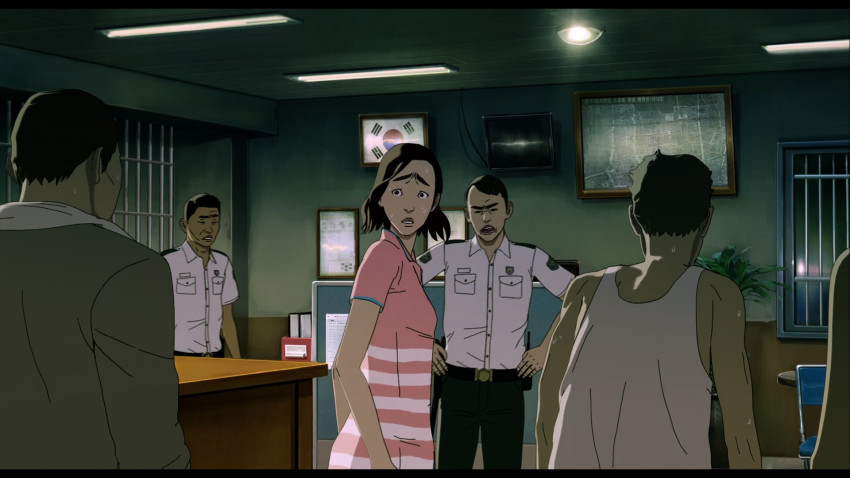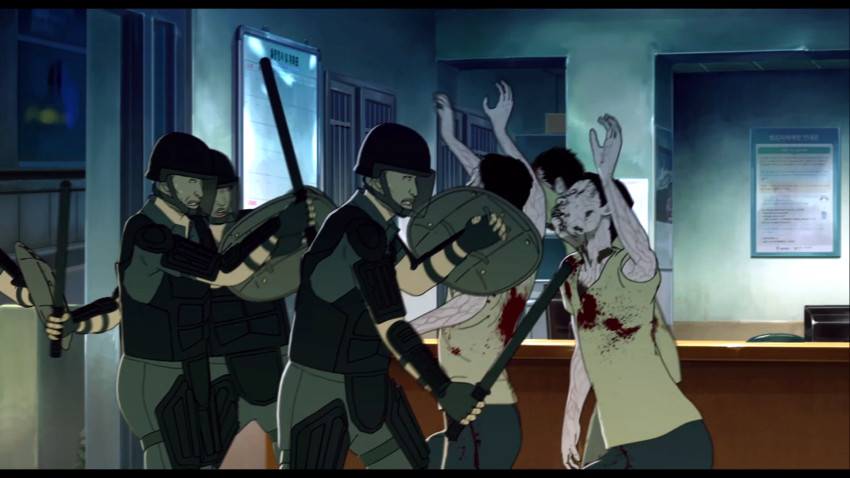Seoul Station
April 3, 2017 · 0 comments
By Andrew Osmond.
It’s not unknown for live-action films to have “companion” films in animation, usually made as spin-offs. The classic case is The Animatrix, a Japanese-Korean anthology made to tie in with The Matrix Reloaded, and the better of the two. Another anime anthology, Batman: Gotham Knight was theoretically tied in with The Dark Knight, though the in-film connections were unconvincing. A third case was Tales of the Black Freighter, cartooning the comic-in-a-comic in Alan Moore’s Watchmen. It was effectively a long deleted scene from Zack Snyder’s Watchmen movie.
On the face of it, Seoul Station is that kind of thing – an animated companion piece to Train to Busan, last year’s horror-action epic about a train plunging through hordes of zombies in South Korea. One surprise, though, is that director Yeon Sang-ho made both films back-to-back, and he made most of Seoul Station first. There’s a greater surprise, though, for anyone who boggled at the speed and dynamism of Train to Busan. Yeon’s pre-Busan career was not in live-action, but in animation.
Based in Seoul himself, Yeon started making animated shorts from 2003. Some readers may have seen his first animated feature, The King of Pigs, which had a UK cinema release from Terracotta Distribution and is available on DVD. It’s a bitter, non-fantasy drama about youth violence (trailer). Yeon said many of its scenes were based on his own experience. He also professes himself a lover of anime; while Miyazaki is his hero, King of Pigs was more influenced by the work of Satoshi Kon. The film won multiple awards and glowing reviews.
Yeon’s second animated feature, The Fake (trailer) is about a religious con man who dupes a rural village. It doesn’t seem to have been released in Britain, but it was acclaimed elsewhere, winning Best Animation at Sitges. Compared to The Fake and King of Pigs, Seoul Station and Train to Busan are clearly more commercial, as works in one of horror’s biggest sub-genres, the zombie apocalypse. Then again, zombies have been viewed as political statements since Romero.
One interview with Yeon suggests he saw the zombie double-bill as a way to sneak social comment into genre fare. He imagined “making an interesting zombie film where zombies are among the people protesting for the democratisation of Korea.” Seoul Station cost about half a million dollars; a modest budget, but more than treble that of The King of Pigs. Train to Busan was reportedly made for about $10 million, which is astonishing considering some of the images on screen.
 Seoul Station is officially a prequel to Train to Busan, but you can watch it independently. There are crossover themes, but no shared characters or plotlines. If you’ve seen Busan, you’ll remember the main characters drive into Seoul in the small hours to catch their train. They don’t realise the apocalypse has started, with glimpses of blazing buildings and madly rushing fire engines.
Seoul Station is officially a prequel to Train to Busan, but you can watch it independently. There are crossover themes, but no shared characters or plotlines. If you’ve seen Busan, you’ll remember the main characters drive into Seoul in the small hours to catch their train. They don’t realise the apocalypse has started, with glimpses of blazing buildings and madly rushing fire engines.
The animated film rewinds a few hours, to show the early escalation of the crisis. The first Infected on screen is a homeless man, shunned and ignored as he collapses in the gutter, an on-the-nose identification of zombies with the underclass. (There’s another homeless man in Busan, who’s the only one to appreciate what’s happening while everyone ignores him.) The outbreak starts the usual Romero way: bite, infect, bite, infect, ad infinitum.
Compared to Busan, Seoul Station has far fewer characters. Aside from the screaming crowds of extras, the film follows two flung-together couples in separate strands. On the one hand, there’s Hye-sun, a runaway girl, who’s with another homeless man. On the other, there’s Hye-sun’s dad, Suk-gyu, who’s frantically trying to find her, forcibly enlisting the help of her deadbeat ex-boyfriend, Ki-woong. Ki-woong, we should explain, is a boyfriend who tries to pay his debts by getting Hye-sun to turn tricks, then beating her when she objects.
Whereas Busan’s action was largely confined to the title train, plus stations and sidings, Seoul Station roams the city. The characters run around rooftops, hotels and subways – the only “siege” is a brief one, when several characters hole up in a prison cell while zombies slaver at the bars. It seems a safe refuge except that (uh oh!) someone in the cell was already bitten. The urban runaround, plus the dynamic of a male character desperately seeking his girl, recalls a non-zombie disaster pic, Cloverfield.
There’s an early scene in a Seoul cybercafé – South Korea’s gaming addiction is well publicised. The action in both films feels highly “gamified”, which is not a criticism when it’s well-handled and the stakes established. As such, Seoul Station has games of Dodge the Zombies, Whack the Zombies and Stay the Heck Away from Zombies; the latter comes as the characters are in an ambulance going to hospital, thinking they’re safe, and then realise that’s where the bite victims are going.
In the early scenes, the animation must be endured; much of it feels crude, with over-amped emoting, and the good shots often let down by weaker shots just after. Once the action starts, the visuals become less distracting, except for small annoyances – for example, when a zombie is hit on the head with a toilet lid, the connection isn’t remotely convincing. There’s also what may be an unwelcome anime influence – frequent knicker flashes for Hye-sun, which are weirdly prevalent in later scenes after we’ve learned to care for her as a character. Admittedly, she has a meltdown in the subway, but carries on walking moments later – no Barbara catatonia here.
The main disappointment is the film’s ending. Both Busan and Seoul Station conclude on unusual notes for zombie films; Busan seems poised to end in a very traditional (zombie) way, but throws in a heart-rending extra twist. Seoul Station has a shock development, but unfortunately it doesn’t work; it’s too silly, even as a payoff to set-ups in the film. It doesn’t ruin the ending, but it’s a let-down bordering on a cheat, and leaves one wondering if better ends were discarded along the way.
Seoul Station isn’t as good as Train to Busan, but it’s a largely engaging horror film – still an underworked genre in animation, even after umpteen anime gore-fests. Its thematic crossovers are clear – each film centres on daddy-daughter relationships taken different ways, while the homeless are repeatedly betrayed by a state-sponsored creed of aspiration, while authorities show only flickers of compassion beneath their callousness in a crisis. The social themes are often buried under heaps of living dead, but the subtler flavours blend better in the double bill. Bon appetit.
Andrew Osmond is the author of 100 Animated Feature Films. Seoul Station is released on UK Blu-ray by Studio Canal.

Leave a Reply